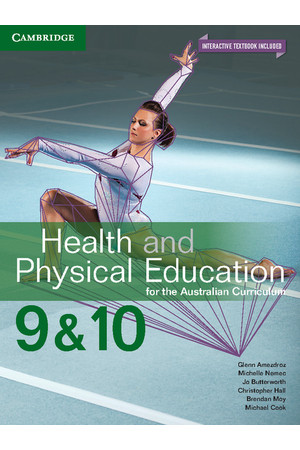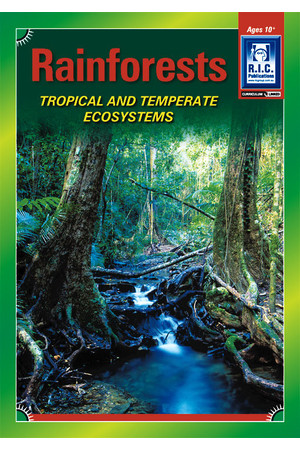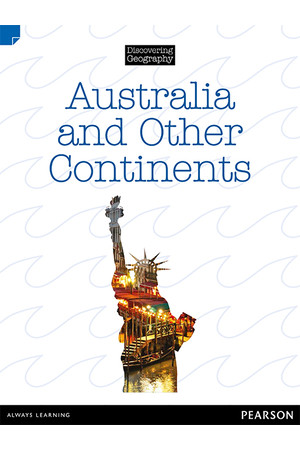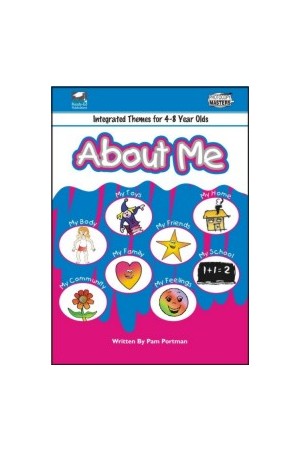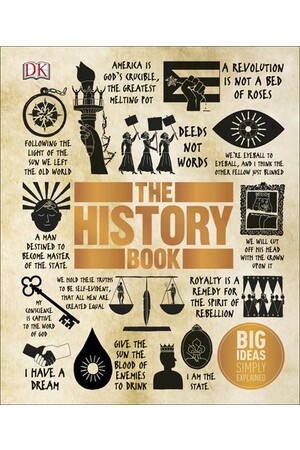Part of the series Humanities Alive Victorian Curriculum.
View all products in this series
Jacaranda Humanities Alive 10 Victorian Curriculum | Third Edition
Developed by expert Australian teachers for ALL students.
Every lesson in the new Jacaranda Humanities Alive series has been carefully designed to support teachers and to help students by sparking curiosity and engagement through discussion and Humanities skills activities.
Because both what and how students learn matter.
Learning is personal
Students: Access lessons tailored to your needs, with interactive content and support to help you progress confidently.
Teachers: Deliver engaging, differentiated lessons with built-in scaffolding and tools to support every learner.
Learning is effortful
Students: Challenge yourself, build confidence, and grow through purposeful practice on Australia’s leading platform.
Teachers: Encourage persistence with tasks that develop resilience and drive meaningful learning outcomes.
Learning is rewarding
Students: See your progress in real time, recognise your strengths, and focus on where to improve.
Teachers: Use rich analytics to track growth and target support exactly where and when it’s needed.
Table of Contents
Meet our author team vii
About This Resource ix
Acknowledgements xvi
Understanding cognitive verbs
History
1 Historical concepts and skills 1
1.1 Overview 2
1.2 Historical concepts and skills 4
1.3 SkillBuilder: Historical questions
1.4 SkillBuilder: Chronology
1.5 SkillBuilder: Using historical sources
1.6 SkillBuilder: Continuity and change
1.7 SkillBuilder: Causes and consequences
1.8 SkillBuilder: Historical significance
1.9 SkillBuilder: Communicating
1.10 Review 16
2 Australians at war: World War II 19
2.1 Overview 20
2.2 What do sources tell us about World War II? 22
2.3 What caused World War II? 26
2.4 How was Japan involved? 32
2.5 Where did Australians fight up to 1942? 37
2.6 Why did Australians fight on the Kokoda Track? 42
2.7 How did Japan change the war for Australia? 46
2.8 What were the experiences of Australian POWs? 51
2.9 What were the causes and impacts of the Holocaust? 56
2.10 What was the war like on the Australian home front? 61
2.11 How did Australian women contribute to the war effort? 67
2.12 How did the war end and what was its lasting significance? 73
2.13 How were Australia’s international relations changed by the war? 77
2.14 Inquiry: Honouring Aboriginal and Torres Strait Islander Australians’ World War ii service 81
2.15 Review 83
3 Rights and freedoms (1945 to present) 89
3.1 Overview 90
3.2 What do sources tell us about rights and freedoms? 92
3.3 How did the Aboriginal and Torres Strait Islander Peoples’ protest movement begin? 96
3.4 What did the members of the Stolen Generations experience? 101
3.5 Who were the significant individuals in the world’s civil rights movements? 106
3.6 What impact did the Freedom Ride have in Australia? 112
3.7 What was the significance of the 1967 Referendum? 116
3.8 What have the Torres Strait Islanders experienced during their fight for freedom? 121
3.9 Why was the Aboriginal Embassy significant? 127
3.10 How are land rights and protests crucial in the struggle for rights and freedoms? 131
3.11 Why is the journey to reconciliation complex? 138
3.12 Why is the fight for equity still going? 144
3.13 How are Indigenous Peoples recognised around the world? 152
3.14 How have women influenced Australian politics? 159
3.15 How has the status of Australian women changed? 165
3.16 How far have we come for the women’s rights movement? 171
3.17 Inquiry: Comparing perspectives of Australian history 176
3.18 Review 178
4 Popular culture and environment movement 187
4.1 Overview 188
4.2 What do sources tell us about the modern world? 190
4.3 How did Australian society change after World War II? 193
4.4 How did sport impact Australian society after World War II? 199
4.5 How did music impact Australian society after World War II? 204
4.6 How did television and film impact Australian society after World War II? 209
4.7 How have standards of living changed since 1945? 214
4.8 What were the origins of the environmental movement? 218
4.9 How do we respond to climate change? 227
4.10 Inquiry: How have teenagers’ perspectives changed? 233
4.11 Review 235
5 Migration experiences 241
5.1 Overview 242
5.2 How did Australia’s immigration policies change during the twentieth century? 244
5.3 What were the experiences of migrants in Australia? 249
5.4 How has Australia’s immigration policy continued to evolve? 254
5.5 How are asylum seekers and refugees treated in Australia? 261
5.6 What is immigration like in Australia today? 266
5.7 Inquiry: How has the government shaped immigration? 269
5.8 Review 273
6 Political crisis and conflict 277
6.1 Overview 278
6.2 Examining the evidence 280
6.3 What was the Cold War in Asia? 283
6.4 Anti-communism in Australia and the US 289
6.5 Why was there a war in Vietnam? 294
6.6 Vietnam and Australian politics 302
6.7 ‘It’s time’ - the Whitlam victory in 1972 310
6.8 The Whitlam dismissal, 1975 315
6.9 The Whitlam legacy 322
6.10 Review 327
Geography
7 Geographical concepts and skills 333
7.1 Overview 334
7.2 Geographical concepts and skills 336
7.3 SkillBuilder: Geographical inquiry
7.4 SkillBuilder: Concluding and decision-making
7.5 SkillBuilder: Communicating
7.6 SkillBuilder: Reading topographic maps at an advanced level
7.7 SkillBuilder: Comparing an aerial photograph with a topographic map
7.8 SkillBuilder: Using geographic imaging systems
7.9 SkillBuilder: Constructing and interpreting a scattergraph
7.10 SkillBuilder: Using multiple data formats
7.11 SkillBuilder: Constructing and describing complex choropleth maps
7.12 SkillBuilder: Comparing aerial photographs to investigate spatial change over time
7.13 SkillBuilder: Building a map with GIS
7.14 Review 344
8 Land-based environmental change and management 347
8.1 Overview 348
8.2 How do we interact with the environment? 350
8.3 Why is our climate changing? 357
8.4 How do we tackle climate change? 363
8.5 Causes and effects of environmental change 368
8.6 What are the impacts of desertification and salinity? 378
8.7 What are the impacts of native and invasive species? 390
8.8 How do cities impact the environment? 400
8.9 Case studies in urban growth - Melbourne and Mumbai 404
8.10 What are the future challenges of sustainable urban environments? 412
8.11 Aboriginal and Torres Strait Islander Peoples’ approaches to custodial responsibility and environmental management 416
8.12 Investigating topographic maps: managing environmental change in the Parwan Valley 422
8.13 Inquiry: Aboriginal and Torres Strait Islander Peoples’ land practices 425
8.14 Review 427
9 Water-based environmental change and management 435
9.1 Overview 436
9.2 How are coasts changing? 438
9.3 What are the challenges to coastal environments? 447
9.4 How do we manage coastal change? 455
9.5 Investigating topographic maps: Consequences of coastal change in Merimbula 461
9.6 What is special about marine environments? 463
9.7 How does debris change marine environments? 469
9.8 What strategies are in place to deal with marine litter? 474
9.9 What is inland water? 482
9.10 Why do we dam rivers and divert water? 486
9.11 How do we use wetlands? 491
9.12 Investigating topographic maps: Wetlands along the Murray River 500
9.13 Inquiry: What are the threats to the Great Barrier Reef? 502
9.14 Review 504
10 Measuring and improving wellbeing 509
10.1 Overview 510
10.2 What is human wellbeing? 512
10.3 How is development and wellbeing measured? 518
10.4 How are life expectancy and wellbeing connected? 522
10.5 How does poverty affect wellbeing? 530
10.6 How can we improve human wellbeing in India? 537
10.7 How does wellbeing vary in Australia? 543
10.8 Investigating topographic maps: Improving wellbeing in Cumborah 550
10.9 Inquiry: Improving wellbeing in a low-HDI-ranked country 552
10.10 Review 554
11 Global responses to human wellbeing 559
11.1 Overview 560
11.2 The United Nations and the Sustainable Development Goals (SDGs) 562
11.3 The United Nations health campaigns 568
11.4 The United Nations and human rights 573
11.5 The United Nations and refugees 578
11.6 How does the Australian government support human wellbeing? 582
11.7 What is the role of non-government organisations in improving human wellbeing? 587
11.8 Investigating topographic maps: Spatial variations in wellbeing in Tokyo, Japan 591
11.9 Inquiry: What are the global responses to human wellbeing? 593
11.10 Review 595
Civics and Citizenship
12 Civics and Citizenship concepts and skills 601
12.1 Overview 602
12.2 Civics and Citizenship concepts and skills 604
12.3 SkillBuilder: Investigating contemporary Civics and Citizenship issues
12.4 SkillBuilder: Evaluating democratic institutions and systems
12.5 SkillBuilder: Participating in civic processes
12.6 SkillBuilder: Communicating
12.7 Review 608
13 Government and democracy 611
13.1 Overview 612
13.2 What are the key features of Australia’s system of government? 614
13.3 What are the key features of India’s system of government? 621
13.4 What are the key features of Indonesia’s system of government? 625
13.5 What are the key features of China’s system of government? 631
13.6 How does Australia act as a regional and global citizen? 635
13.7 What are Australia’s roles and responsibilities as part of the United Nations? 640
13.8 How does Australia play a role in international peacekeeping and global regional issues? 647
13.9 Inquiry: Report card - Australia’s response as a global citizen 653
13.10 Review 655
14 Laws and citizens 661
14.1 Overview 662
14.2 Australia’s obligations under international law 664
14.3 International treaties, conventions and declarations 668
14.4 Australia’s obligations to Aboriginal and Torres Strait Islander Peoples through international law 674
14.5 Australia’s legal obligations to the environment 682
14.6 Inquiry: Treaty 688
14.7 Review 690
15 Citizenship, diversity and identity 695
15.1 Overview 696
15.2 What are the elements of a cohesive society? 698
15.3 What threatens social cohesion? 702
15.4 What threatens democratic societies globally? 708
15.5 How can we resolve conflict? 712
15.6 Inquiry: What is inclusiveness? 716
15.7 Review 717
Economics and Business
16 Economics and Business concepts and skills 721
16.1 Overview 722
16.2 Economics and Business concepts and skills 724
16.3 SkillBuilder: Investigating
16.4 SkillBuilder: Interpreting and analysing data
16.5 SkillBuilder: Evaluating, concluding and decision-making
16.6 SkillBuilder: Communicating
16.7 Review 733
17 Economic performance and living standards 737
17.1 Overview 738
17.2 How does Australia perform economically? 740
17.3 What are the trends in employment in Australia? 745
17.4 What is the level of inflation in Australia? 750
17.5 What do the sustainability indices tell us? 755
17.6 What are Australia’s living standards like? 761
17.7 What are macroeconomic policy options? 766
17.8 How does the government intervene in markets? 773
17.9 Inquiry: How does Australia measure up? 778
17.10 Review 779
18 Business and entrepreneurship 783
18.1 Overview 784
18.2 What influences consumer decision-making? 786
18.3 Why is innovation important to businesses? 791
18.4 How does entrepreneurship improve business operations? 795
18.5 How do entrepreneurs respond to changing economic conditions? 800
18.6 What is human resource management? 805
18.7 What is the role of trade unions and employer groups in a workplace? 810
18.8 Inquiry: Aboriginal and Torres Strait Islander entrepreneurs and business practices 815
18.9 Review 817
Glossary 821
Index 834
| ISBN | 9781394339648 |
| Publisher | Jacaranda |
| Product Type | Student Books, |
| Year Level | Year 10, |
Be The First To Review This Product!
Help other Teacher Superstore users shop smarter by writing reviews for products you have purchased.







